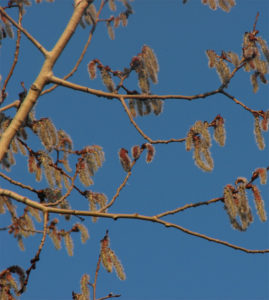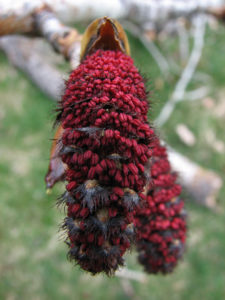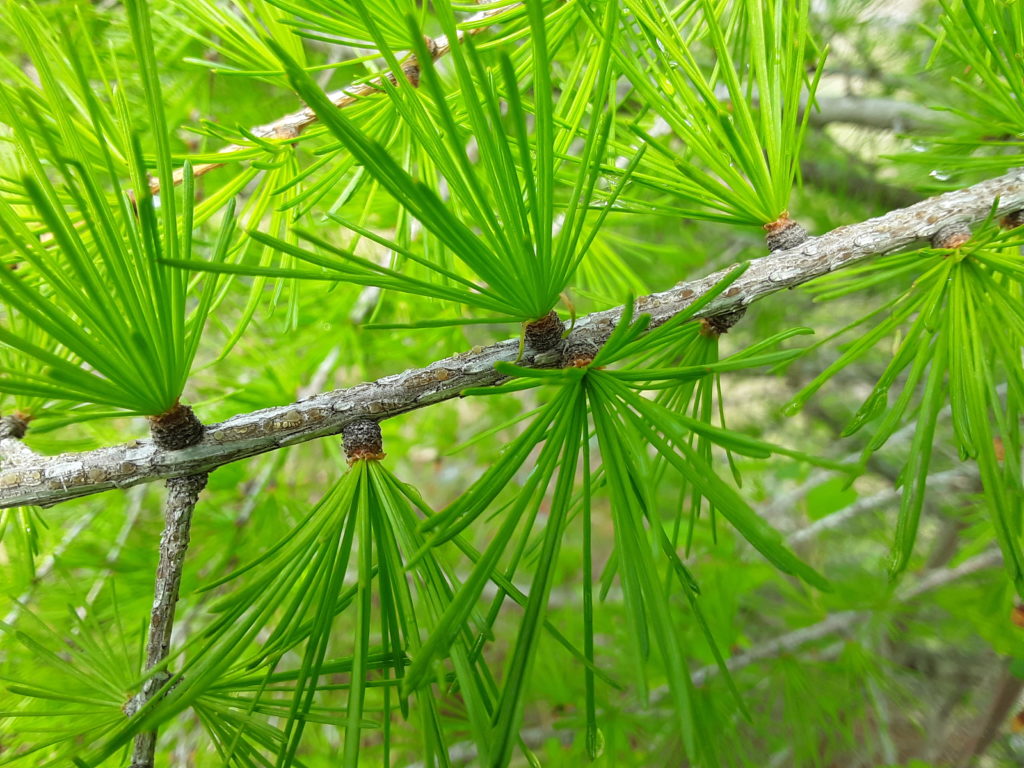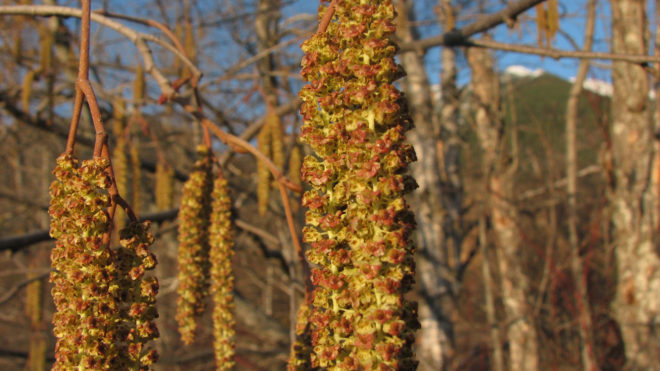Lengthening daylight hours bring the first flowers of the season. Rather than sprouting up from the Earth, they dangle in the sky. These sky flowers are the pendant, petal-less, yellow and amber-colored catkins of alder. Regardless of the weather, they release their golden pollen about the time we celebrate calendar Spring on March 20th.
By the last week of March, the  plump, fuzzy pussywillow-like flower buds of aspen appear. A week later, on a chilly April day, their long, soft, silvery catkins sway against a clear, crisp, blue sky.
plump, fuzzy pussywillow-like flower buds of aspen appear. A week later, on a chilly April day, their long, soft, silvery catkins sway against a clear, crisp, blue sky.
The stout, ruby red catkins of cottonwood are next on the list of sky flowers to show up. Though many are too high on the trees to see with clarity, gusty winds snap off some branches and suddenly the catkins are within easy reach for up-close viewing. I marvel at the gem-colored anthers of the flowers, and extend my appreciation to the cottonwoods for these ephemeral beauties.
Alders, aspens and cottonwoods aren’t the only plants with flowers that appear before the leaves emerge.
Along the creek and surrounding wetlands, the pointed yellow hoods of skunk cabbage flowers poke up through snow with determination. This year, the relentless morning frosts are too much for many of them to endure and they slump beneath the 26-degree April low temperatures. Still, there’s hope. Each day, I see the tips of new skunk cabbage blossoms pushing upward. Before long, the enormous leaves of this plant make their debut. Some leaves may reach more than 48-inches in height and 12-inches across.
 By mid-April I begin checking the western larch, our deciduous conifer, for their first hint of green needles emerging from small woody knobs located on branches. A month later, the clusters of 15 or more needles are almost full length. What we call needles are actually a type of leaf, and they are as soft as a sable brush. That’s not all. The inch-long tufts of tender needles appear luminescent green even beneath an overcast sky.
By mid-April I begin checking the western larch, our deciduous conifer, for their first hint of green needles emerging from small woody knobs located on branches. A month later, the clusters of 15 or more needles are almost full length. What we call needles are actually a type of leaf, and they are as soft as a sable brush. That’s not all. The inch-long tufts of tender needles appear luminescent green even beneath an overcast sky.
This May’s mixed sun and cloud forecasts frequently include snow, hail, sleet, rain, wind and intermittent morning frosts. Such conditions are representative components of springtime in the Rockies. Weather becomes the focus of conversations with neighbors as we greet each other while out on walks. Many express frustrations about a lack of spring and I listen to their complaints and agree that more sun and warmth would be nice. But after a while, my mind begins wandering. . .
What subtle signs of spring will I notice today?
Capturing Seasonal Changes
Don’t let the fickle weather of springtime slow your enthusiasm for noticing the seasonal transformations taking place. Here are a few ideas to help you appreciate natural changes:
- Flathead Valley weekly sunrise & sunset. Many people think that the sun only rises in the direction of due east and sets in the direction of due west. Here in northwest Montana, we’re pretty far north. Even though summer solstice is less than a month away (as I write this blog) you may be very surprised by how far to the northeast or north, northeast the sun rises and how far northwest or north, northwest the sun sets as daylight hours lengthen.
Choose one day per week (or every other week) to observe and record the changes in how much farther to the northeast the sun rises, and how much farther to the northwest it sets as we move closer to summer.
- Flathead Valley flowering time. Plants know best when it’s time to bloom.
Keeping track of flowering plants either with photos or in a journal will help you know the cyclic and seasonal changes you can look forward to each year.
- Sounds of the season. What are some of the sounds you hear this time of year?
In addition to birds, what other sounds – near and far- do you notice? Perhaps you’d like to describe these sounds in a journal.
- Scents of the season.
We often overlook our sense of smell. In warm weather and especially after a rain, scents are more noticeable. One of the first scents of spring I notice is an earthy one as frost leaves the ground. As we approach mid and late spring, you might notice scents given off by plants. Along river bottoms, there’s the sweet smell of cottonwoods. The vanilla or butterscotch scent of a large, orange-trunked ponderosa pine is worthy of a sniff particularly when the sun shines on it. Don’t stop there.
Allow your nose to be your guide to spring.


